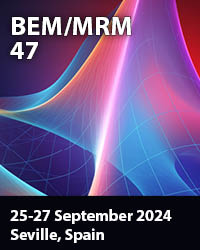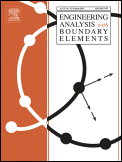Open Access Material
History of Boundary Elements
The PDF document below describes the Early History of Boundary Elements. It is taken from the article by Alexander Cheng and Daisy Cheng of Mississippi University, with kind permission of Elsevier, the copyright holders.
The material appeared in the International Journal of Engineering Analysis with Boundary Elements, Vol 29, Issue #3, pages 268-302, 2005.
Boundary Elements - An Introductory Course

Below are the chapters of the well known book "Boundary Elements. An Introductory Course." by C.A. Brebbia of Wessex Institute of Technology and J. Dominguez of the University of Seville.
The book has been written to provide a simple and up-to-date introduction to the Boundary Element Method. It is based on the authors' long experience teaching boundary elements and is designed to convey, in the most effective manner, the fundamentals of the method.
It is written in a form which enables its use as a text book at undergraduate or graduate level, as well as by the engineer in practice who wishes to learn the fundamentals of the technique.
The book starts with an introductory chapter explaining why boundary elements are needed and their advantages compared with finite elements in the solution of many engineering problems. Other chapters deal with basic concepts, potential problems, elastostatics, combination with finite elements and other topics of interest to engineers.
Demo Codes for Boundary Elements - An Introductory Course
 Below are software codes for "Boundary Elements. An Introductory Course." by C.A. Brebbia and J. Dominguez.
Below are software codes for "Boundary Elements. An Introductory Course." by C.A. Brebbia and J. Dominguez.
They consist of six FORTRAN codes and nine data files. Each FORTRAN file contains one main program and all the associate subroutines in such a way that each file only needs to be compiled and linked with the FORTRAN library to be ready to run.
The FORTRAN files are:
- POCONBE.FOR: Potential Constant Boundary Elements Program
- POLINBE.FOR: Potential Linear Boundary Elements Program
- POQUABE.FOR: Potential Quadratic Boundary Elements Program
- POMCOBE.FOR: Potential Multiboundary Constant Boundary Elements Program
- ELCONBE.FOR: Elastic Constant Boundary Elements Program
- ELQUABE.FOR: Elastic Quadratic Boundary Elements Program
The data files are
- PC12HF.DAT: Heat Flow Problem using 12 Constant Elements (Example 2.1)
- PL12HF.DAT: Heat Flow Problem using 12 Linear Elements (Example 2.2)
- PL04HF.DAT: Heat Flow Problem using 4 Linear Elements (Example 2.3)
- PQ10ES.DAT: Elliptical Section under Torsion using 10 Quadratic Elements (Example 2.4)
- PQ05ES.DAT: Elliptical Section under Torsion using 5 Quadratic Elements (Example 2.5)
- EC24CC.DAT: Circular Cavity under Internal Pressure using 24 Constant Elements (Example 4.1)
- EQ12CC.DAT: Circular Cavity under Internal Pressure using 12 Quadratic Elements (Example 4.2)
- EQ06RP.DAT: Rectangular Plate under Flexural Moment using 6 Quadratic Elements (Example 4.3)
- EQ12CB.DAT: Cantilever Beam under Flexure using 12 Quadratic Elements (Example 4.4)
Files for download:
- Chapter 2.4 (ZIP - 20.6 KB)
- Chapter 2.6 (ZIP - 24.8 KB)
- Chapter 2.8 (ZIP - 29.9 KB)
- Chapter 2.9 (ZIP - 20.8 KB)
- Chapter 4.5 (ZIP - 32.4 KB)
- Chapter 4.8 (ZIP - 47.5 KB)
Please note all files are compressed as ZIP archives.
Open Access Material
Over 30,000 Open Access papers are available to download from the WIT eLibrary, including many on boundary elements and related fields.
Click 'Read More' below for links to the freely available content.




